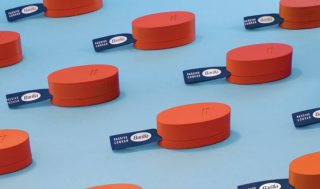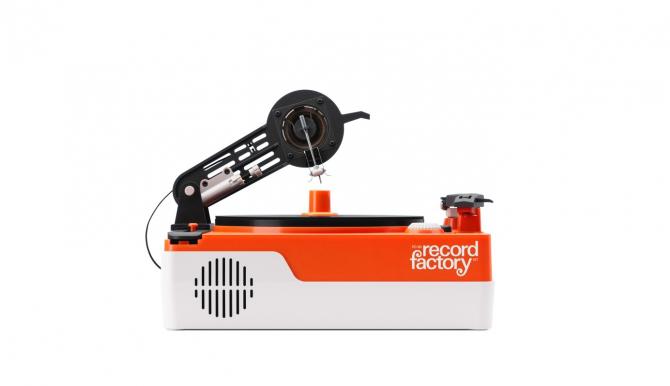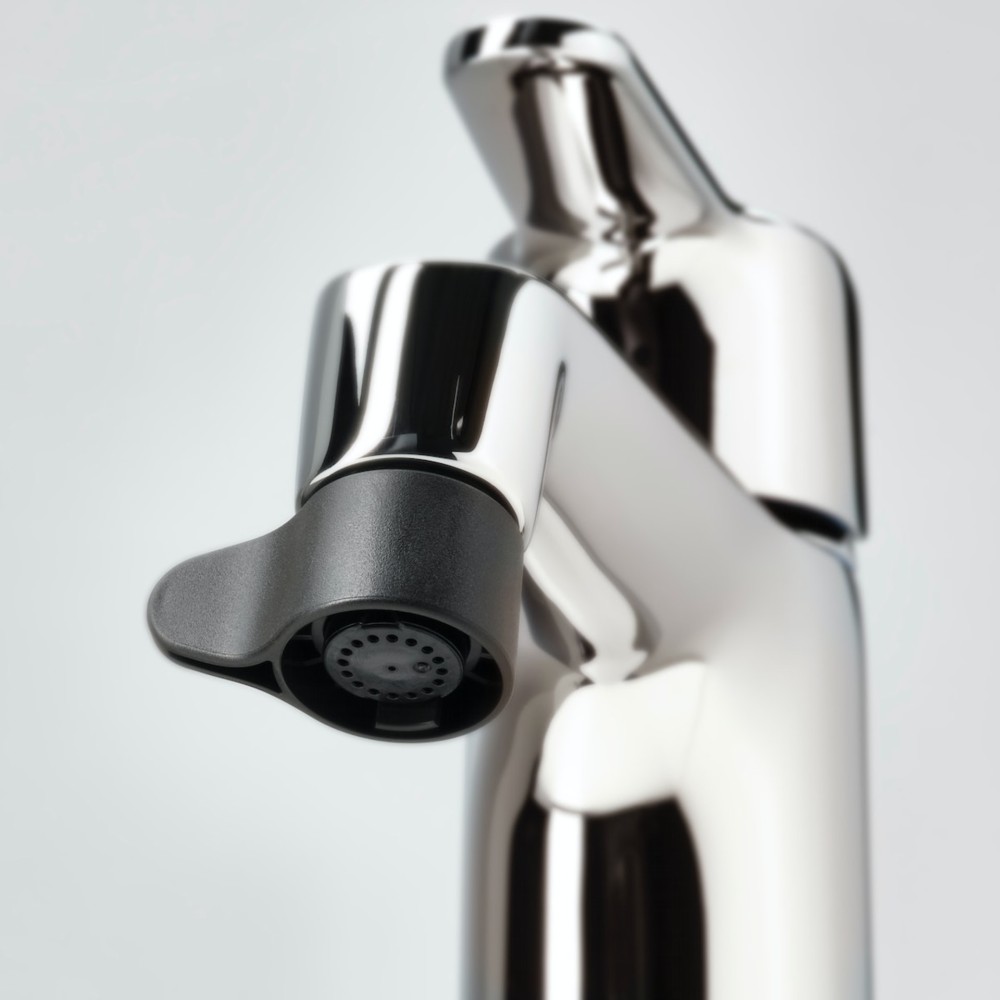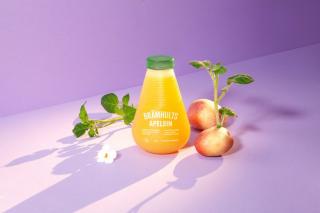Magazine
Design incorporates objects, people,
ideas based on the small pleasures of everyday life.
Meet your Beautiful design world with the DDP Design Fair.
-

Cook your pasta “passively”
2023-10-12 Cookers that reduce carbon by up to 80%Pasta giant Barilla recommends passive cooking of pasta. Passive in the sense that it utilizes the residual heat after a period of cooking, rather than active heating, which involves keeping the heat on the entire time the pasta is being cooked. To this end, Barilla has released a device called the Passive Cooker and a dedicated mobile app to help you cook passively.Here‘s how it works. You place the Passive Cooker on the lid of a pot, and the device notifies you via the app when the water is boiling. This means it‘s time to add the pasta to the water. After two minutes, the app will notify you again to let you know it‘s time to turn off the heat. After two minutes of active heating, it‘s time for passive residual heat. The residual heat from the boiling water will finish cooking the pasta. At this point, the passive cooker on the lid of the pot will detect the residual heat and let you know how long it will take for the pasta to be fully cooked, again via the app.In fact, there‘s not much difference between the normal cooking time and the passive cooking time. If you‘re cooking macaroni, for example, it takes 7 minutes to cook conventionally, but with passive cooking it takes 2+6 minutes, or only 1 minute more. Instead, you only need to turn on the stove for two minutes, which means your gas or electricity bill will be much lower, and your carbon footprint will be reduced by up to 80%, says Barilla.Barilla has open-sourced the manufacturing information for the Passive Cooker, which will notify you when it‘s time to passively cook. The 3D printed case, printed with 100% biodegradable filament, houses two AAA batteries, a temperature sensor, and an Arduino board. Barilla has made the device‘s open source files and instructions available for download on its website. However, if you don‘t want to build your own passive cooker, Barilla offers a chatbot via WhatsApp. It guides you step-by-step on how to passively cook pasta.*Source: Design Korea 2022-2022 Design Trendsdesignkorea.kidp.or.kr/bbs/board.php?bo_table=trend&wr_id=64 barilla.com/en-gb/passive-cooking
2023-10-1271 -

DIY vinyl record maker from Teenage Engineering
Easy and futuristic for kidsTeenage Engineering should be a familiar name to anyone interested in music. The Stockholm company was born out of a love of music and electronics. Since the success of its first product, the OP-1 synthesizer, in 2010, Teenage Engineering has developed sound equipment sought after by professional musicians such as Thom Yorke, Depeche Mode, Beck, and Bon Iver, as well as consumer products such as hardware for game consoles, hi-fi radios, instant cameras, and AI speakers. Teenage Engineering is also the type of company that IKEA would collaborate with, as evidenced by their Frekvens light and sound system for home parties. Teenage Engineering is in a unique position where their sound engineering skills and product design are inextricably linked. Their new product, the PO-80, is the crystallization of exactly what they do best, but for a very special user: the PO-80 Record Factory Kit, is a DIY vinyl record-making machine for kids that‘s a combination turntable and record cutter. Teenage Engineering collaborated with Yuri Suzuki, an up-and-coming designer, to create the PO-80. This small, refreshingly colored device allows anyone to connect their own audio equipment via a 3.5mm jack to imprint music onto a record, record it, and play it right back. The resulting 5-inch records have the warm, lo-fi, analog sound of those early records. As a DIY music-making device, the PO-80 is meant to be assembled and completed by the user. An impressive product that will introduce children to the joy of music that they can physically touch and create, the TP-80 also comes with accessories such as blank records, a record cutting head, and a storage bag. *Source: Design Korea 2022-2022 Design Trendsdesignkorea.kidp.or.kr/bbs/board.php?bo_table=trend&wr_id=55&page=2Teenage Engineering website: teenage.engineeringVideo on the P0-80: youtube.com/watch?v=p4Syxl8lKOA
2023-10-1277 -

Ikea‘s
The best way to conserve water at homeWater efficiency is becoming an increasingly important issue. One third of the world‘s population does not have access to safe drinking water, and by 2030, billions of people are expected to lack access to safe drinking water and sanitation. Currently, 10% of the world‘s fresh water is used at home, so IKEA has come up with a small add-on tool to help you save water at home. It’s called Åbächen and it’s a water-saving nozzle. All of Ikea‘s showerheads and faucets already have built-in controls to make them more water-efficient, but now the company has introduced a separate nozzle that fits onto your existing faucet. IKEA collaborated with Swedish innovation startup Altered Company to create Åbächen, a universal nozzle that fits most standard faucets on the market, as well as existing IKEA faucets, and reduces water consumption by 0.25 liters per minute in mist mode and 1.9 liters per minute in spray mode. With the existing faucet flowing at 5.7 liters per minute, that‘s a saving of at least 66% and as much as 95%. The reduced flow rate naturally saves energy used for hot water as well. "We know that most of the people who are experiencing water shortages are also struggling financially. That‘s why it‘s important to develop solutions that are affordable for households. This cannot be achieved without innovation and collaboration," says Hanna Carleke, Business Leader Bathroom at IKEA. The Åbächen will go on sale this October and is a small step towards saving water. *Source: Design Korea 2022-2022 Design Trendsdesignkorea.kidp.or.kr/bbs/board.php?bo_table=trend&wr_id=47&page=3IKEA website: ikea.comAltered Company website: alteredcompany.com
2023-10-05157 -

Herman Miller x Logitech G = Vantum Gaming Chair
A chair reimagined for gamingThe emergence of gaming chairs as a subcategory of chairs is a recent phenomenon. Chairs aimed specifically at gamers were first introduced by DXRACER in 2006. The market for gaming chairs has grown with the popularization of eSports and the boom in live game streaming, and it‘s now a distinct type of chair that even traditional furniture brands are paying attention to.Herman Miller has also been paying attention to the gaming chair market, having already released gaming versions of existing best-sellers like the Aeron and Sayl, and collaborated with Logitech‘s dedicated gaming brand, Logitech G, to create the Embody Gaming Chair. The latest chair to come out of the collaboration is the Vantum. It‘s not a gaming version of an existing chair, but rather a chair that‘s been reimagined for gaming.The biggest difference between a regular office or study chair and a gaming chair is that when you play games, you sit more upright than when you work, and your body naturally leans forward. Therefore, the key to a gaming chair is to provide good posture and lumbar support even when your body leans forward, and the role of the seat becomes important. The Vantum features a modified seat pad and a posture-fit backrest to support the lower back and provide support to the pelvis to help you achieve proper posture.Another posture that a gaming chair should consider is a relaxed posture. Whether you‘re streaming a game or chatting with friends, leaning back and relaxing is an important part of gaming chairs. For the first time, the Vantum has a padded rib cage on the backrest to ensure that the upper back, neck, and head are properly supported. Unlike other Herman Miller gaming chairs, the Vantum has a headrest as well. A chair for gamers who want to immerse themselves in the game or just kick back and relax. The design is bold visually and physically, yet lightweight, flowing, and sculptural, for the modern gamer. Herman Miller and Logitech G‘s new chair, the Vantum, is available in three colors – Polar White, Flare Red and Obsidian Black - and is priced at $995.*Source: Design Korea 2022-2022 Design Trendsdesignkorea.kidp.or.kr/bbs/board.php?bo_table=trend&wr_id=65&page=1Herman Miller website: store.hermanmiller.com/gaminglogitechg website: logitechg.com
2023-10-0583 -

Zaha Hadid Design Launches Seyun, a Solid Wood Furniture Collection
Furniture that embraces everyday life with KarimokuDuring Milan Design Week at the historic Museo Bagatti Valsecchi, Zaha Hadid Design unveiled the Seyun collection of solid wood chairs and tables. This is the first time the collection, which includes chairs, armchairs, and tables in a variety of sizes, has been released outside of the U.S. Seyun chairs have already been introduced in Japan. The Seyun line is a collaboration between Japanese wooden furniture manufacturer Karimoku and Zaha Hadid Design. The two companies began the project in 2016, before the untimely passing of architect Zaha Hadid (founder of Zaha Hadid Design Studio), and worked together during COVID-19."The design was developed before Zaha Hadid passed away, so she was able to see it in person. If she had seen the finished chair, she would have loved it and wanted to produce it," says Maha Kutay, Zaha Hadid Design Director.The work with Karimoku also speaks to Zaha Hadid‘s love of Japan, Maha Kutai adds. "One of the first projects she did was the interior for Monsoon restaurant in Tokyo, so she‘s always loved Japan." The Seyun chair is made by turning a piece of wood and it has a unique gap where the wood meets the wood. "The structure of the Seyun chair is completely different from a traditional chair," says Hiroshi Kato, vice president of Karimoku. "A traditional chair has two front legs, a seat, and a backrest. The Seyun chair consists of three asymmetrical parts. At the same time, we wanted to create a chair that is everyday, practical, comfortable, and durable," adds Kato. The tables, which come in two sizes, also feature a unique design. The patterns on the small and large tables match, and the modular design allows them to be combined to create a unit. The goal of Zaha Hadid Design Studio and Karimoku was to create furniture that is suitable for everyday use. "We wanted to create an everyday chair that you can use in your living room and touch and feel every day, not like an exhibition chair in a museum," says Woody Yao, Zaha Hadid Design Director. Seyun - Zaha Hadid Design for Karimoku was on view at Museo Bagatti Valsecchi, Via Gesù 5, Via Geschi 5, from April 18 to 23, 2023. Photo: Luke Hayesoriginally published by Dezeen. source: dezeen.com/2023/04/24/zaha-hadid-design-seyun-karimoku/
2023-09-2357 -

Nendo designs a beer can with two lids
Whimsy for the perfect beer foamJapanese design studio Nendo has developed an unconventional beer can with two angled pull tabs to control the amount of foam produced when the can is opened. The cylindrical shape of the can features a slender gray container with two numbered pull tabs instead of the traditional single tab. Nendo wanted to create a canned beer that would produce the "most ideal froth" when poured into a glass, without too much or too little foam.The first tab, labeled "1," can be opened slightly to create concentrated pressure inside the can to activate the beer‘s foam. This allows the user to pour the desired amount of foam into a glass before opening the second tab, labeled ‘2‘, which opens the can completely and produces a smooth beer with no foam. Through research, Nendo found that by creating a can with a smaller initial opening, the bubbles created by the pressure drop would be concentrated in a narrow gap, so they placed the two pull tabs at opposite angles to make it as easy as possible for users to open. "The beer head (the top that froths when you pour the beer) is considered, at least in Japan, to be an essential element in making beer more palatable to drink, and a layer of foam of the right thickness acts as a lid that prevents the beer from coming into contact with air and releasing aromas, flavors, and carbonation," Nendo added.Recognizing that most commercial beer is shipped in glass bottles or kegs, while home-brewed beer is typically packaged in aluminum cans, Nendo aimed to create a can that would allow you to control the amount of foam, much like a pint of beer poured into a glass at a bar or restaurant. Known for its minimalist product design, Nendo has previously created a recyclable soap dispenser that looks like a milk carton and a prefabricated soccer ball by interlocking plastic modules.Photo: Provided by Masahiro Ogami.Video: Provided by Yumika Kanechika.originally published by Dezeen.원문/dezeen.com/2023/05/04/nendo-beer-can-two-pull-tabs/ source: dezeen.com/2023/05/04/nendo-beer-can-two-pull-tabs/ NendoNendo designs a beer can with two pull tabsTraditional can-shaped productsNendo, who developed a can for people who want to pour the perfect beer at home
2023-09-23115 -

Allbirds, the world‘s first zero-carbon shoe
Bioplastic-soled sneakers unveiledAt the Global Fashion Summit in Copenhagen, Allbirds unveiled the Moonshot sneaker, a wool sock-style sneaker with a bioplastic sole. The minimalist, all-gray Moonshot sneaker features wool from a Regenerative Farm (which captures more carbon than it emits) in New Zealand for its upper. Allbirds announced that the Moonshot sneaker is the "world‘s first net-zero carbon shoe," meaning it produces zero carbon emissions over its lifecycle."Naturally derived, carbon-neutral products are an untapped opportunity and the future of fashion," said Tim Brown, co-founder of Allbirds. In 2021, Allbirds launched the Futurecraft Footprint Trainer in collaboration with Adidas, which set a record for the lowest carbon footprint ever at 2.94 kg CO2e. Since then, the team has focused on simplifying the structure of the trainer, which has an average carbon footprint of 13.6 kilograms, and reducing the number of individual parts from 65 to seven. The Moonshot sneaker also features no laces or eyelets, and the insole is attached to the knit upper. Unlike previous Futurecraft Footprint trainers, the Moonshot features a merino wool upper from a zero-carbon certified farm in New Zealand (Lake Hawea Station), which sequesters more carbon than it emits through regenerative farming practices. Plastics still play an important role in performance. Recycled wool hasn‘t quite caught up to the performance of synthetic fibers yet, so the Moonshot‘s upper had to incorporate some recycled nylon and polyester for durability and stretch. For the midsole, they used a supercritical foaming process to increase the bioplastic content from 18% in 2021 to 70% in the Moonshot sneaker. The process involves injecting gas into the midsole to increase durability and lightweight, while reducing the need for synthetic additives that are more emissions-intensive. The front of the sneaker features a bioplastic smiley face badge from California company Mango Materials, which is made by capturing methane released from wastewater treatment facilities and then digested by bacteria into a biopolyester called PHA. The shoes themselves are vacuum-packed in bioplastic polyethylene to save space and weight during transportation, which Allbirds plans to do via electric trucks and container ships powered by biofuels. In 2020, Allbirds became the first fashion brand to offer carbon labeling on all of its products and is committed to reducing the carbon footprint of its products to less than one kilogram by 2030 and reducing its overall carbon footprint to "near zero“. The Moonshot sneaker is scheduled to launch in spring 2024.
2023-09-2382 -

GoneShells, a potato starch-based edible juice bottle.
Shockingly, it can be peeled and eaten like fruitDesign studio Tomorrow Machine has created a biodegradable juice bottle made from a potato starch-based material that can be peeled off like a fruit peel and eaten, composted, or dissolved. The bottle, called GoneShells, is a prototype currently being developed by the studio in collaboration with Brämhults, the juice brand of global juice company Eckes Granini. Anna Glansén, founder of Tomorrow Machine, said she wanted a name that symbolized a natural way to protect food, like fruit peel or eggshell. The curved bottle is made of a potato starch-based material and is coated with a bio-based waterproof barrier on both the inside and outside to preserve the juice. After drinking the juice, the bottle is spirally peeled in the same way as a fruit, which breaks the barrier and immediately starts the decomposition process of the material. The peel can then be eaten or dissolved in water. Tomorrow Machine is unable to disclose more details about the material at this time, but says it is biodegradable, compostable, and contains no synthetic ingredients. According to the creators, Goneshells can be manufactured using existing equipment designed to process fossil fuel-based thermoplastics. The material design also aims to address the issue of landfills and the lack of recycling and industrial composting facilities in some parts of the world. Branding agency F&B HAPPY, which worked on the project, says it started with the question, "Does it make sense for a package to last for years or decades when its contents spoil after just a few days or weeks? The prototype bottle includes a green lid made from a potato starch-based material. The packaging currently features hand-foiled lettering, but F&B HAPPY said it is working on a printing solution that "fits the concept of the bottle. The shells were informed by the Tomorrow Machine‘s previous project, called "This Too Shall Pass," an edible packaging with a lifespan that matches the lifespan of the food in the packaging. Source: dezeen.com/2023/03/06/goneshells-edible-juice-bottle/Originally published by Dezeen
2023-09-2383





